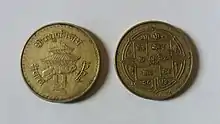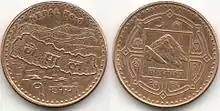Nepalese rupee
The Nepalese rupee (Nepali: रुपैयाँ; symbol: रु, ₨; code: NPR) is the official currency of the Federal Democratic Republic of Nepal. The Nepalese rupee is subdivided into 100 paisa. The issuance of the currency is controlled by the Nepal Rastra Bank, the central bank of Nepal. The Nepalese rupee was introduced in 1932 when it replaced the Nepalese mohar at the rate 2:1.
| Nepalese rupee | |
|---|---|
| रुपैयाँ (Nepali) | |
| ISO 4217 | |
| Code | NPR |
| Denominations | |
| Subunit | |
| 1/100 | Paisa |
| Symbol | रु ₨ (plural), Re (singular) |
| Banknotes | |
| Freq. used | रू5, रु10, रु20, रु50, रु100, रु500, रु1000 |
| Rarely used | रु1, रु2, रु25, रु250 |
| Coins | |
| Freq. used | रु1, रु2 |
| Rarely used | 1, 5, 10, 25, 50 paisa, रु5, रु10 |
| Demographics | |
| Date of introduction | 1932 |
| User(s) | |
| Issuance | |
| Central bank | Nepal Rastra Bank |
| Website | www |
| Valuation | |
| Inflation | 7.1% |
| Source | Nepal Rastra Bank, November 2015 |
| Pegged with | |
| Pegged by | ₹1 = रु1.6000 (buy) ₹1 = रु1.6015 (sell) |
Prior to 1994, the Nepalese rupee (रु) was pegged to the Indian rupee (₹) at the rate रु.45 = ₹1, however, since then it has been pegged at the rate रु1.60 = ₹1 currently.[2]
History
The rupee was introduced in 1932, replacing the silver mohar at a rate of 2 mohar = 1 rupee. At first, the rupee was called the Mohru in Nepali. Its value was pegged to the Indian Rupee in 1994 at a rate of 1.6 Nepalese rupees = 1 Indian rupee.[3]
1945–1955
Rupees in Nepal and Pakistan were worth the same amount. Early banknotes which were issued between 1945 and 1955 during the rule of King Tribhuvan were put into circulation by the Sadar Muluki Khana (The Treasury) as Nepal did not have a Central Bank at that time. Notes issued under the reign of King Tribhuvan were therefore not signed by a bank governor, but by a Kajanchi (Head of the Treasury) who also serves as a Hindu high-priest. As such, Nepal’s early paper currency probably include the only bank-notes in the world which were signed by a high-priest. These early notes were printed by the Indian Security Press in Nashik and do not have any security features, except for watermarks and the special paper on which they are printed.
1955–1972
Starting with King Mahendra, who succeeded his father Tribhuvan in 1955, banknotes were issued by Nepal Rastra Bank (Nepal National Bank) which was founded on 26 April 1956. The signature of the governor of this institution is found on all banknotes which were issued after this date.
Under King Mahendra, the Nepalese Government became “His Majesty’s Government” (in Nepalese "Shri Paanch ko Sarkar”, literally; “the government of the five times honoured”) and remained this way during the rule of Birendra and Gyanendra. Two series of banknotes were issued during the rule of King Mahendra: The first series shows the King in civilian clothes wearing the Nepalese “topi”, while on the notes of the second series the King is shown in military uniform. The second series comprised higher denominations of 500 and 1000 rupees notes, which had not been issued before.
1972–2001

During King Birendra’s rule, one can also distinguish between two major series of banknotes. The first series features the king wearing the military uniform while on the notes of the second series the king is wearing the traditional Nepalese crown adorned with feathers of the bird of paradise. During this period regular banknotes of 2 and 20 rupees and special banknotes of 25 and 250 rupees were issued for the first time. The legends found on the last issues of Gyanendra revert to Nepal sarkar ("Nepalese government"), thus omitting the reference to the king.
2007–2012


In October 2007, a 500-rupee note was issued on which the king’s portrait was replaced by Mt. Everest. This reflects the historic change from a kingdom to a republic which took place in May 2008 in Nepal. Further notes of 5, 10, 20, 50, 100 and 1000 rupees with Mt. Everest and without reference to the king in their legends followed in 2008. The first issues of the 500- and 1000-rupee notes were printed on paper which still had the king's crowned portrait as a watermark in the "window" on the right part of the face of the notes. It was decided to print a red Rhododendron flower (Nepal's national flower) on top of the watermark. Notes of these denominations which were issued in 2009 and thereafter are printed on paper which has a Rhododendron flower as watermark instead of the royal portrait and were therefore released without the additional overprint in red.
Banknotes
On 17 September 1945, the government introduced notes for 5, 10 and 100 rupees, with the name mohru used in Nepalese.[4] There are also 25- and 250-rupee notes commemorating the Silver Jubilee of Birendra Bir Bikram Shah in 1997. Since 2007, Nepalese rupee banknotes have been produced by Perum Peruri, the mint company of Indonesia.[5]
In 2012, Nepal Rastra Bank issued a revised banknote series that is similar to the 2007 series, but now include inscriptions in English and the year of issue on the back.
| 2012 Mount Everest series (current) | ||||||
|---|---|---|---|---|---|---|
| Image | Value | Main Colour | Description | Date of issue | ||
| Obverse | Reverse | Obverse | Reverse | |||
| 5 rupees | Lilac and pink | Mount Everest; temple of Taleju; obverse of coin | Two yaks grazing; Mount Everest | 2012 | ||
| 5 rupees | Lilac and pink | Mount Everest; Kasthamandap Temple | Yak | 2017 | ||
| 10 rupees | Brown and green | Mount Everest; Garud Narayan of Changu Narayan temple | Three black bucks grazing; trees; bank logo | 2012 | ||
| 10 rupees | Brown and green | Mount Everest; Garud Narayan of Changu Narayan temple | Antelope; trees; bank logo | 2017 | ||
| 20 rupees | Orange and Brown | Mount Everest; temple of god Krishna of Patan; Garuda atop pillar | Swamp deer; trees; mountain; bank logo | 2012 | ||
| 20 rupees | Orange and Brown | Mount Everest; temple of god Krishna of Patan; Garuda atop pillar | Sambar deers; trees; mountain; bank logo | 2016 | ||
| 50 rupees | Purple, Green and Blue | Mount Everest; Rama-Janaki temple of Janakpur | Male tahr; mountains; bank logo | 2012 | ||
| 50 rupees | Purple Green and Blue | Mount Everest; Rama-Janaki temple of Janakpur | Snow leopard; bank logo | 2016 | ||
| 100 rupees | Green and Lilac | Mount Everest; Mayadevi inside silver metallic oval; map of Nepal; Ashoka pillar; wood carvings from temple of Taleju in Kathmandu; description "Lumbini – Birthplace of Lord Buddha" | One-horned rhinoceros in grassy plain; bank logo | 2012 | ||
| 100 rupees | Green and Lilac | Mount Everest; Mayadevi inside silver metallic oval; map of Nepal; Ashoka pillar; wood carvings from temple of Taleju in Kathmandu; description "Lumbini – Birthplace of Lord Buddha" | One-horned rhinoceros and its offspring in grassy plain; bank logo | 2015 | ||
| 500 rupees | Brown and violet | Mount Everest; god Indra; Mount Amadablam and Thyangboche monastery; wood carvings; clouds | Two tigers drinking melted snow | 2012 | ||
| 500 rupees | Brown and violet | Mount Everest; god Indra; Mount Amadablam and Thyangboche monastery; wood carvings; clouds | Tiger | 2016 | ||
| 1,000 rupees | Blue and gray | Mount Everest, Swayambhunath stupa & Harati temple | Elephant | 2013 | ||
| 1,000 rupees | Blue and gray | Mount Everest, Swayambhunath stupa & Harati temple | Twin Asian Elephants | 2019 | ||
| For table standards, see the banknote specification table. | ||||||
See also
| Current NPR exchange rates | |
|---|---|
| From Google Finance: | AUD CAD CHF EUR GBP HKD JPY USD INR CNY USD |
| From Yahoo! Finance: | AUD CAD CHF EUR GBP HKD JPY USD INR CNY USD |
| From XE.com: | AUD CAD CHF EUR GBP HKD JPY USD INR CNY USD |
| From OANDA: | AUD CAD CHF EUR GBP HKD JPY USD INR CNY USD |
| From fxtop.com: | AUD CAD CHF EUR GBP HKD JPY USD INR CNY USD |
References
- "Nepal Rastra Bank". nrb.org.np. Retrieved 13 June 2016.
- "'Nepal to keep currency pegged to Indian rupee' | Business Line". Thehindubusinessline.com. 2018-01-11. Retrieved 2019-05-13.
- "Archived copy". Archived from the original on 2007-02-19. Retrieved 2007-03-11.CS1 maint: archived copy as title (link)
- Linzmayer, Owen (2012). "Nepal". The Banknote Book. San Francisco, CA: www.BanknoteNews.com.
- "Archived copy". Archived from the original on 2017-05-08. Retrieved 2010-05-05.CS1 maint: archived copy as title (link)
- Agrawal (Giriya), Shyam and Gyawali, Kamal Prasad: Notes and Coins of Nepal. Nepal Rastra Bank Golden Jubilee Year 2005/06, Kathmandu, 2006.
- Bertsch, Wolfgang: "The Legends on the Banknotes of Nepal", International Banknote Society (IBNS) Journal, vol. 48, no. 3, 2009, p. 39–44.
- Jha, Hari Jaya: An Overview of Nepalese Paper Money. Manjeeta Jha, Lalitpur (Patan), B.S. 2058 (= A.D. 2001).
- Lorenzoli, Giovanni: “Nepali artistic buildings as seen on Nepali notes”. Journal of the International Banknote Society, vol. 43, no. 3 (2004), p. 6–14.
- Shrestha, Ramesh: Nepalese Coins & Bank Notes (1911 to 1955). Kazi Mudhusudan Raj Bhandary, Kathmandu, 2007.
- Wittmann, Hans: Die Banknoten des Königreichs Nepal. Unpublished, Wiesbaden, 2002.
Sources
- Krause, Chester L.; Clifford Mishler (1991). Standard Catalog of World Coins: 1801–1991 (18th ed.). Krause Publications. ISBN 0873411501.
- Pick, Albert (1994). Standard Catalog of World Paper Money: General Issues. Colin R. Bruce II and Neil Shafer (editors) (7th ed.). Krause Publications. ISBN 0-87341-207-9.
External links
- Heiko Otto (ed.). "Historical and current banknotes of Nepal" (in English and German). Retrieved 2017-05-29.